-
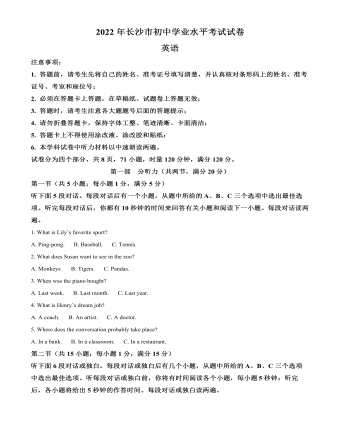
2022年湖南省长沙市中考英语真题(原卷版)
In ourdaily lives, we are often given some boring or tiring tasks. What’s in yourmind when your mom tells you to clean the floor? Have you ever wanted tocomplain(抱怨)? I think most people have.

2022年湖南省郴州市中考英语真题(解析版)
Apassenger told an air hostess(空姐)that he needed a cup of water to take hismedicine when the plane just took off. She told him that she would bring himthe ___11___ in ten minutes.
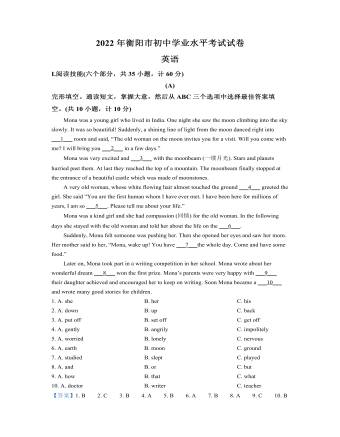
2022年湖南省衡阳市中考英语真题(解析版)
Some schools have organized too many tests thatare too difficult. As a result, students have to study hard all the time andthey have been under a lot of stress. It has been harmful to students’ mental (心理的)and physical health and it must be changed.

2022年湖南省衡阳市中考英语真题(原卷版)
The boy named Li Banghua is from Hefei. AnhuiProvince. He made the plane completely by himself. The plane is 0.6 meterswide, has a wingspan (翼展) of 4.4 meters and weighs about 40 kilograms.According to a local report, Li just finished his high-school entrance exam ayear ago and got good grades.
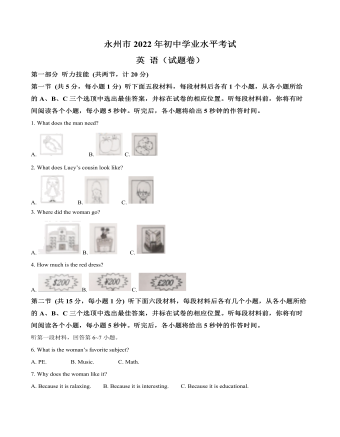
2022年湖南省永州市中考英语真题(解析版)
Parents and children often face the challengesof money. Common topics include setting pocket money, learning to save, anddeciding to buy expensive things. The goal of most parents is to teach theirkids how to deal with money wisely. The goal of most kids is getting money tospend. How can families achieve these goals?
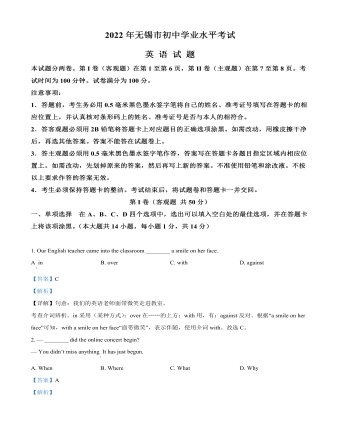
2022年江苏省无锡市中考英语真题(解析版)
Jared ___15___ to stay at home, but his mom sent him anyway.He had to sit next to Jessica. At reading time, Mrs. Thomas asked Jared toread. Reading aloud always made Jared ___16___ . As he picked up the book, his hands shook.“He can’t read,” Jessica said. “I didn’t call on you, did I?”
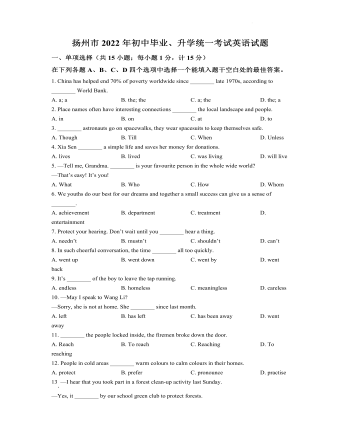
2022年江苏省扬州市中考英语真题(原卷版)
Every month, Julia and her cousins would go forthe big family meal at their grandparents’ house. On each visit, their grandpawould give them a few coins. Then all the children would run off to buy sweets.One day, he gathered the children together.
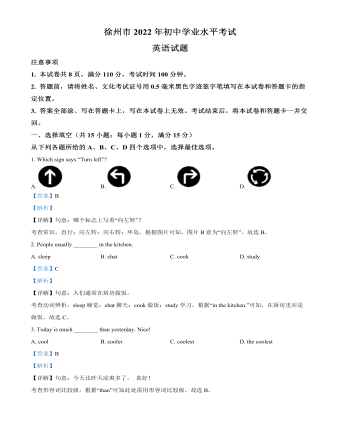
2022年江苏省徐州市中考英语真题(解析版)
Du, 23,is a student from Shanghai University. He won third place at the ninth IOIO (国际折纸奥林匹克) in February this year. A total of 803 competitors from 59countries and areas took part in this year’s event.

2022年江苏省常州市中考英语真题(解析版)
Russia’s skating silver medalist AlexandraTrusova, 17, amazed the world with five quadruple jumps (四周跳)during free skate at the Beijing Winter Olympics. No other woman has everfinished five quadruple jumps in an Olympic competition.
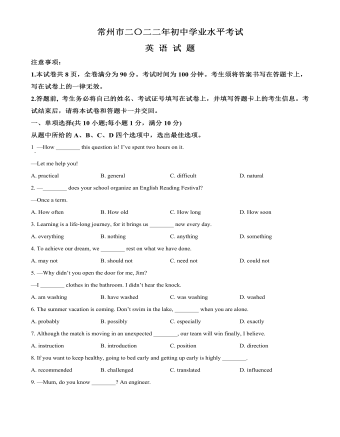
2022年江苏省常州市中考英语真题(原卷版)
At 9 a.m. , he drives to primary schools and middle schools in Xi’an, ShaanxiProvince, to teach students about Shaanxi kuaiban. It is a traditional Chineseform of storytelling to the rhythm(节奏) of bamboo clappers(响板), whichthe art form is named after. Sometimes, he helps students prepare forcompetitions. Usually, his classes run until about 6. p.m. , and then hereturns home to prepare classes for the next day.
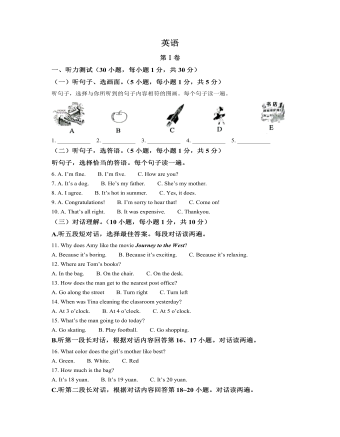
2022年广西贺州市中考英语真题(解析版)
Flying kites Kites have quite a long history. The earliest kites were made ofwood, instead of paper. Nowadays, the three most famous kites are the Beijingkite, Tianjin kite, and Weifang kite. And they are quite different from eachother. For example, the swallow-shaped kite is a well-known Beijing style.
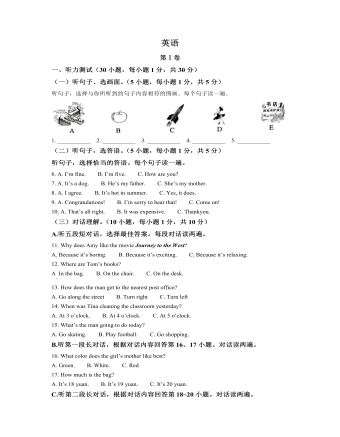
2022年广西贺州市中考英语真题(原卷版)
Once upona time, two brothers lived in a village. They were both famers and grew corn.The elder brother had many children to feed. The younger brother also had a bigfamily to look after. Although the brothers were poor, they lived happily.

2022年江苏省宿迁市中考英语真题 (解析版)
ThreeRiver-Source National Park on the Qinghai-TibetPlateau(青藏高原),is the largest national park in China. Because it is home to the sources of theYangtze, Yellow and Lancang rivers, people call it “China’s water tower”.
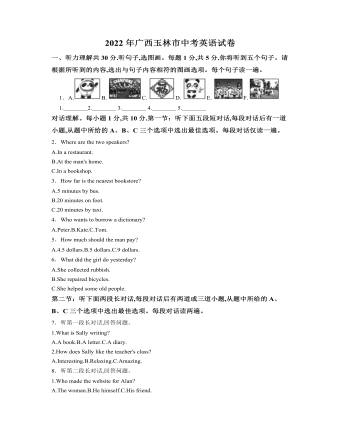
2022年广西玉林市中考英语真题(解析版)
Antarctica is a continent (大陆) of ice. There is hardlyany rain in Antarctica, so the Antarctic Desert becomes the driest desert inthe world. It is also the world’s largest desert by area.
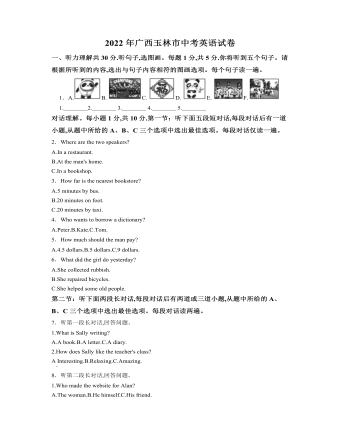
2022年广西玉林市中考英语真题(原卷版)
Lu Junling, a security guard from Hebei University, became popularon the Internet. As an ordinary (平凡) person, though Lu Junling is more than 50 years old, hememorizes English vocabulary for CET 6 under the street lights every day justto improve himself. When he is free, he also writes novels and sings operas.That’s not all! Painting, music, kongfu, ancient poems, etc. are all hishobbies. So a number of people call him “treasure security guard (宝藏保安)”. Lu Junling said, “If I want to become an artist, I will alwayswork hard for my dream!” Mr. Lu’s words live in many people’s memory.
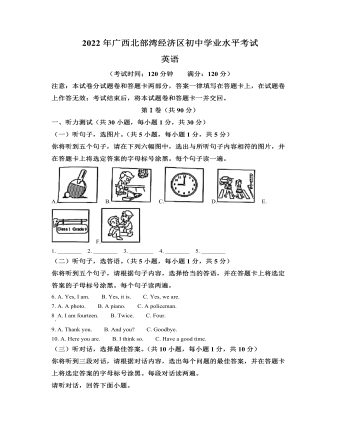
2022年广西北部湾经济区中考英语真题(解析版)
Ibelieved that I was right and he was wrong, and Tony believed that I was wrongand he was right. Our teacher, a kind and smart lady, decided to teach us alesson. She brought us to the front of the class and placed him on one side ofher desk and me on the other. In the middle of her desk was a large and roundobject. I could clearly see that it was black. The teacher asked us what colorthe object was. “White,” Tony answered. I couldn’t believe he said the objectwas white! “Clearly, it was black!” Another argument started between Tony andme, this time about the color of the object.
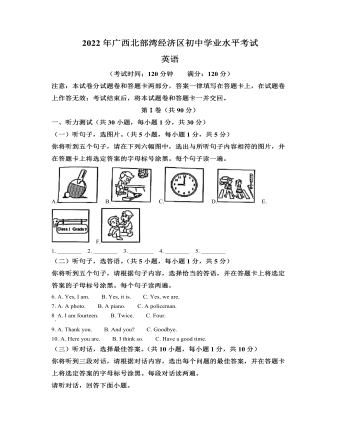
2022年广西北部湾经济区中考英语真题(解析版)
Ibelieved that I was right and he was wrong, and Tony believed that I was wrongand he was right. Our teacher, a kind and smart lady, decided to teach us alesson. She brought us to the front of the class and placed him on one side ofher desk and me on the other. In the middle of her desk was a large and roundobject. I could clearly see that it was black. The teacher asked us what colorthe object was. “White,” Tony answered. I couldn’t believe he said the objectwas white! “Clearly, it was black!” Another argument started between Tony andme, this time about the color of the object.
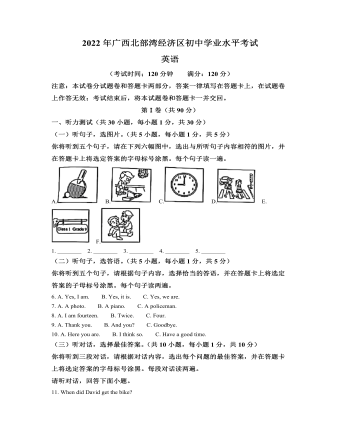
2022年广西北部湾经济区中考英语真题(原卷版)
Ibelieved that I was right and he was wrong, and Tony believed that I was wrongand he was right. Our teacher, a kind and smart lady, decided to teach us alesson. She brought us to the front of the class and placed him on one side ofher desk and me on the other. In the middle of her desk was a large and roundobject. I could clearly see that it was black. The teacher asked us what colorthe object was. “White,” Tony answered. I couldn’t believe he said the object waswhite! “Clearly, it was black!” Another argument started between Tony and me,this time about the color of the object.
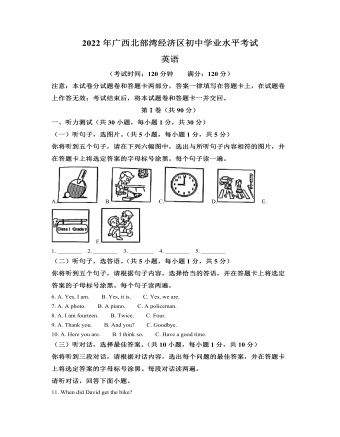
2022年广西北部湾经济区中考英语真题(原卷版)
By usingthis method, the study found that red meats were the most unfriendly foods tothe environment. Keeping farm animals produces a large number of methane(甲烷)that keeps 30 times more heat than CO2. As well asmaking the earth warmer, eating too much red meat is known to increase the riskof a few illnesses, such as heart trouble.

2022年广东省广州市中考英语真题(解析版)
When youand your friends turn to each other to talk about problems or troubles, yougive each other advice and help. One important thing of our growth is to makedecisions to help our friends and learn to support each other. This requires usto learn what it means to help friends and how to help them in right ways.





















